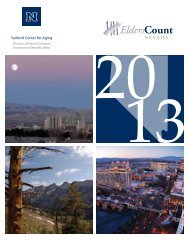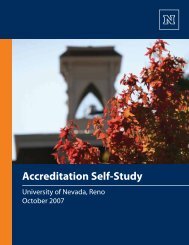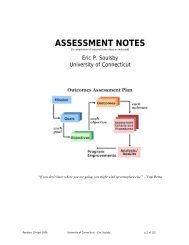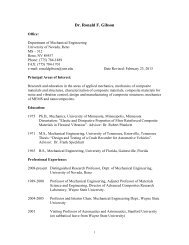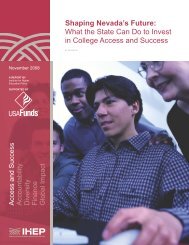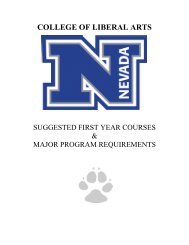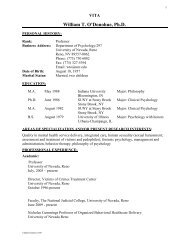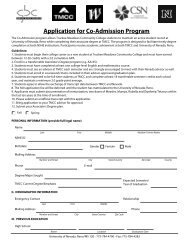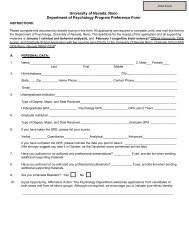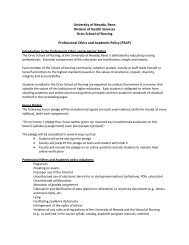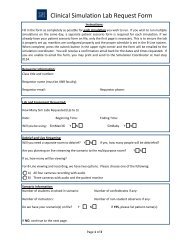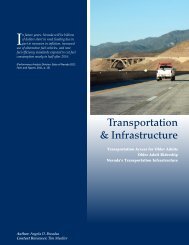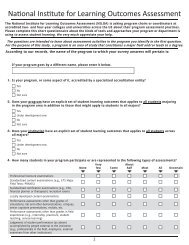Nevada Silver and Blue - University of Nevada, Reno
Nevada Silver and Blue - University of Nevada, Reno
Nevada Silver and Blue - University of Nevada, Reno
- TAGS
- nevada
- reno
- www.unr.edu
Create successful ePaper yourself
Turn your PDF publications into a flip-book with our unique Google optimized e-Paper software.
On the Campus Move<br />
SIDE NOTES:<br />
• As a result <strong>of</strong> Tim<br />
Casey’s global effort<br />
to affect Internet<br />
laws, publisher John<br />
Wiley & Sons asked<br />
Casey to write a book,<br />
ISP Liability Survival<br />
Guide: Strategies for<br />
Managing Copyright,<br />
Spam, Cache, <strong>and</strong><br />
Privacy Regulations,<br />
which it published in<br />
2000.<br />
• Casey was a Sigma<br />
Nu fraternity brother<br />
while attending<br />
<strong>Nevada</strong>.<br />
• While at Santa Clara<br />
<strong>University</strong> School <strong>of</strong><br />
Law, Tim Casey<br />
distinguished himself<br />
by publishing an<br />
award-winning paper<br />
about trademark law<br />
<strong>and</strong> becoming the<br />
first part-time<br />
student to serve as<br />
editor-in-chief <strong>of</strong> the<br />
Santa Clara Computer<br />
& High Technology<br />
Law Journal.<br />
14 <strong>Nevada</strong> <strong>Silver</strong> & <strong>Blue</strong> • March/April 2004<br />
“There were recent grads from MIT, Stanford<br />
<strong>and</strong> Cal-Tech — some <strong>of</strong> the well-known<br />
engineering schools. I found that I knew as<br />
much or more than they did. I certainly had a<br />
better grasp <strong>of</strong> the practical things that you<br />
needed to know as an engineer. I realized,<br />
‘Wow!’ my education at <strong>Nevada</strong> was really first<br />
rate.”<br />
Casey was enjoying his work as an engineer,<br />
but as it turned out, he not only recovered from<br />
his difficult start at McGeorge, he managed to<br />
place in the top 20 percent <strong>of</strong> his class.<br />
“I had to make a decision,” he recalls. On the<br />
one h<strong>and</strong>, he wanted to pursue a law degree,<br />
on the other, he wanted to keep his engineering<br />
job. So he worked out a transfer to Santa Clara<br />
<strong>University</strong> School <strong>of</strong> Law that allowed him to<br />
be a full-time engineer <strong>and</strong> a part-time student.<br />
“I didn’t go to law school with the intent <strong>of</strong><br />
becoming an intellectual property attorney, I<br />
just thought my background would be a good<br />
combination,” he says. “I saw all these high<br />
technology companies with lawyers with<br />
political science <strong>and</strong> English majors —<br />
wouldn’t it be a good idea to be an engineer<br />
<strong>and</strong> a lawyer who could underst<strong>and</strong> both the<br />
technology <strong>and</strong> the law?”<br />
A good idea it was. While in law<br />
school, he studied for <strong>and</strong> passed the patent<br />
registration examination, a federal requirement<br />
to represent inventors before the Patent Office.<br />
Passing this exam led him to leave his engineering<br />
job for a full-time job clerking <strong>and</strong><br />
writing patent applications for the law firm<br />
Rosenblum, Parish & Bacigalupi. After graduating,<br />
Casey worked for the firm, then for leading<br />
Silicon Valley companies such as Apple <strong>and</strong><br />
Silicon Graphics, Inc. (SGI), working with some<br />
<strong>of</strong> the best engineers in the world <strong>and</strong> staying<br />
at the forefront <strong>of</strong> the latest in high-tech<br />
innovations.<br />
“At Apple, I worked on numerous advanced<br />
technology projects, such as h<strong>and</strong>held computers,<br />
s<strong>of</strong>tware technologies, <strong>and</strong> the Power PC<br />
microprocessor, which was a joint development<br />
project between IBM, Apple <strong>and</strong> Motorola. I<br />
was one <strong>of</strong> the attorneys who put that deal<br />
together,” he says.<br />
SGI was a startup company known for<br />
inventing graphics technologies used to create the<br />
special effects in movies, design cars <strong>and</strong> predict<br />
weather when Casey became its head intellectual<br />
property counsel. Through SGI, Casey became<br />
involved with the White House Information<br />
Infrastructure Task Force, the Clinton<br />
administration’s response to the nascent Internet.<br />
“The Internet was becoming something <strong>and</strong><br />
thanks to the World Wide Web, it became easy<br />
to use <strong>and</strong> began to grow significantly. Along<br />
with that growth came concern that copyrighted<br />
content would be easily copied <strong>and</strong><br />
distributed over the Internet. The content<br />
companies — the movie industry, the recording<br />
industry — were very worried about the<br />
impact the Internet would have on their<br />
businesses,” Casey recalls.<br />
SGI was, at that time, working on an interactive<br />
television project with Time Warner, one <strong>of</strong><br />
the top content companies.<br />
“Time Warner was pressuring SGI to support<br />
them within the Task Force for legislation that<br />
would modify copyright law to make Internet<br />
service providers (ISPs), the access <strong>and</strong><br />
network operators <strong>of</strong> the Internet, liable for<br />
infringing material put on the Internet by<br />
users.”<br />
Then Casey took a job at MCI — the dominant<br />
ISP. “So suddenly, I went from a company<br />
that wasn’t going to have liability as a result <strong>of</strong><br />
this legislation, to a company that was going to<br />
have most <strong>of</strong> the liability.”<br />
But MCI, along with other communications<br />
companies, was busy concentrating its lobbying<br />
efforts on the Telecommunications Act,<br />
which eventually passed in 1996. Casey<br />
seemed to be the only person concerned about<br />
the pending copyright bill.<br />
“This bill will kill the Internet,” Casey<br />
remembers thinking. If ISPs were held liable for<br />
anything that their customers put on a Web<br />
page or sent in an e-mail, the price <strong>of</strong> using the<br />
Internet would skyrocket to <strong>of</strong>fset the litigation<br />
<strong>and</strong> liability the ISPs would surely face.<br />
Taking the lead from a case in which the<br />
Church <strong>of</strong> Scientology convinced an ISP to<br />
remove infringing customer material when the<br />
church complained, Casey formulated an<br />
amendment to the legislation based on a<br />
concept he dubbed “notice <strong>and</strong> take down.”<br />
A lobbyist at MCI introduced Casey to U.S.<br />
Rep. Rick Boucher from Virginia, who accepted<br />
the amendment <strong>and</strong> connected Casey with a<br />
group <strong>of</strong> people interested in supporting notice<br />
<strong>and</strong> take down. As a result, Casey became the<br />
co-founder <strong>of</strong> the Ad Hoc Copyright Coalition, a<br />
group sustaining this effort on behalf <strong>of</strong> all ISPs,<br />
telephone <strong>and</strong> s<strong>of</strong>tware companies, universities<br />
<strong>and</strong> a variety <strong>of</strong> other entities. One <strong>of</strong> the<br />
Coalition’s hardest tasks was explaining to<br />
people what the Internet was <strong>and</strong> how it<br />
worked. As the only engineer involved, this task<br />
largely fell to Casey. “We fought like mad <strong>and</strong><br />
really worked the issue,” says Casey, recalling



